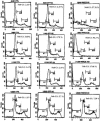WWOX gene restoration prevents lung cancer growth in vitro and in vivo
- PMID: 16223882
- PMCID: PMC1266103
- DOI: 10.1073/pnas.0505485102
WWOX gene restoration prevents lung cancer growth in vitro and in vivo
Expression of concern in
-
Editorial Expression of Concern: WWOX gene restoration prevents lung cancer growth in vitro and in vivo.Proc Natl Acad Sci U S A. 2017 Apr 18;114(16):E3365. doi: 10.1073/pnas.1704296114. Epub 2017 Apr 3. Proc Natl Acad Sci U S A. 2017. PMID: 28373548 Free PMC article. No abstract available.
Abstract
The WWOX (WW domain containing oxidoreductase) gene at the common fragile site, FRA16D, is altered in many types of cancer, including lung cancer. We have examined the tumor suppressor function of WWOX in preclinical lung cancer models. The WWOX gene was expressed in lung cancer cell lines through recombinant adenovirus (Ad) infection (Ad-WWOX), and through a drug [ponasterone A, (ponA)]-inducible system. After WWOX restoration in vitro, endogenous Wwox protein-negative cell lines (A549, H460, and H1299) underwent apoptosis through activation of the intrinsic apoptotic caspase cascade in A549 and H460 cells. Ectopic expression of Wwox caused dramatic suppression of tumorigenicity of A549, H460, and H1299 cells in nude mice after Ad-WWOX infection and after ponA induction of Wwox expression in H1299 lung cancer cells. Tumorigenicity and in vitro growth of U2020 (Wwox-positive) lung cancer cells was unaffected by Wwox overexpression. This study confirms that WWOX is a tumor suppressor gene and is highly effective in preventing growth of lung cancer xenografts, whether introduced through viral infection or by induction of a silent WWOX transgene.
Figures






Similar articles
-
Epigenetic modulation of endogenous tumor suppressor expression in lung cancer xenografts suppresses tumorigenicity.Int J Cancer. 2007 Jan 1;120(1):24-31. doi: 10.1002/ijc.22073. Int J Cancer. 2007. PMID: 17019711
-
Adenovirus-delivered wwox inhibited lung cancer growth in vivo in a mouse model.Cancer Gene Ther. 2016 Jan;23(1):1-6. doi: 10.1038/cgt.2015.56. Epub 2015 Oct 30. Cancer Gene Ther. 2016. PMID: 26516139
-
Ectopic WWOX Expression Inhibits Growth of 5637 Bladder Cancer Cell In Vitro and In Vivo.Cell Biochem Biophys. 2015 Nov;73(2):417-425. doi: 10.1007/s12013-015-0654-0. Cell Biochem Biophys. 2015. PMID: 27352332
-
WWOX: a fragile tumor suppressor.Exp Biol Med (Maywood). 2015 Mar;240(3):296-304. doi: 10.1177/1535370214561590. Epub 2014 Dec 22. Exp Biol Med (Maywood). 2015. PMID: 25538133 Free PMC article. Review.
-
WWOX: its genomics, partners, and functions.J Cell Biochem. 2009 Nov 1;108(4):737-45. doi: 10.1002/jcb.22298. J Cell Biochem. 2009. PMID: 19708029 Review.
Cited by
-
WWOX modulates the gene expression profile in the T98G glioblastoma cell line rendering its phenotype less malignant.Oncol Rep. 2014 Oct;32(4):1362-8. doi: 10.3892/or.2014.3335. Epub 2014 Jul 17. Oncol Rep. 2014. PMID: 25051421 Free PMC article.
-
Tumor Suppressor Genes within Common Fragile Sites Are Active Players in the DNA Damage Response.PLoS Genet. 2016 Dec 15;12(12):e1006436. doi: 10.1371/journal.pgen.1006436. eCollection 2016 Dec. PLoS Genet. 2016. PMID: 27977694 Free PMC article. Review.
-
MicroRNA-330-3p promotes cell invasion and metastasis in non-small cell lung cancer through GRIA3 by activating MAPK/ERK signaling pathway.J Hematol Oncol. 2017 Jun 19;10(1):125. doi: 10.1186/s13045-017-0493-0. J Hematol Oncol. 2017. Retraction in: J Hematol Oncol. 2020 Oct 22;13(1):142. doi: 10.1186/s13045-020-00969-0. PMID: 28629431 Free PMC article. Retracted.
-
Low levels of WWOX protein immunoexpression correlate with tumour grade and a less favourable outcome in patients with urinary bladder tumours.Histopathology. 2008 Jun;52(7):831-9. doi: 10.1111/j.1365-2559.2008.03033.x. Epub 2008 Apr 29. Histopathology. 2008. PMID: 18452537 Free PMC article.
-
Tumor suppressor genes FHIT and WWOX are deleted in primary effusion lymphoma (PEL) cell lines.Blood. 2011 Aug 18;118(7):e32-9. doi: 10.1182/blood-2010-12-323659. Epub 2011 Jun 17. Blood. 2011. PMID: 21685375 Free PMC article.
References
-
- Greenlee, R. T., Hill-Harmon, M. B., Murray, T. & Thun, M. (2001) CA Cancer J. Clin. 51, 15–36. - PubMed
-
- Roth, J. A., Nguyen, D., Lawrence, D. D., Kemp, B. L., Carrasco, C. H., Ferson, D. Z., Hong, W. K., Komaki, R., Lee, J. J., Nesbitt, J. C., et al. (1996) Nat. Med. 2, 985–991. - PubMed
-
- Nemunaitis, J., Swisher, S. G., Timmons, T., Connors, D., Mack, M., Doerksen, L., Weill, D., Wait, J., Lawrence, D. D., Kemp, B. L., et al. (2000) J. Clin. Oncol. 18, 609–622. - PubMed
-
- Roth, J. A., Swisher, S. G., Merritt, J. A., Lawrence, D. D., Kemp, B. L., Carrasco, C. H., El-Naggar, A. K., Fossella, F. V., Glisson, B. S., Hong, W. K., et al. (1998) Semin. Oncol. 25, Suppl. 8, 33–37. - PubMed
-
- Weill, D., Mack, M., Roth, J., Swisher, S., Proksch, S., Merritt, J. & Nemunaitis, J. (2000) Chest 118, 966–970. - PubMed
Publication types
MeSH terms
Substances
Grants and funding
LinkOut - more resources
Full Text Sources
Other Literature Sources
Medical
Molecular Biology Databases

